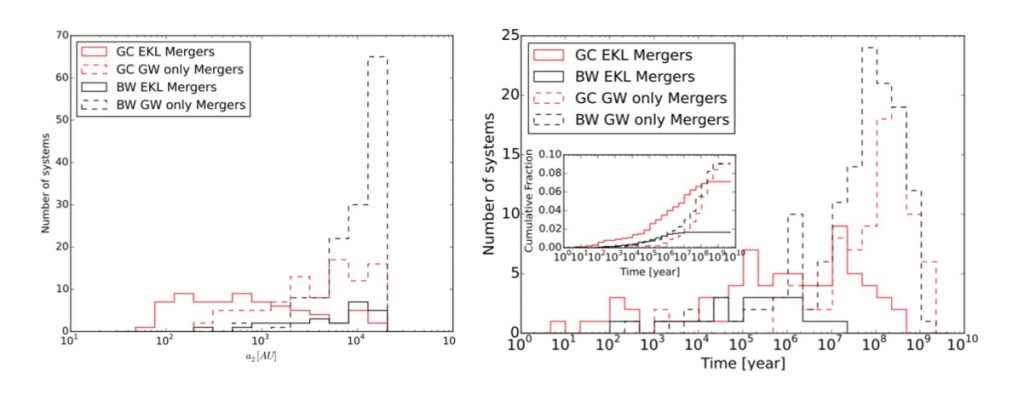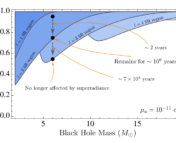Title: Black Hole Mergers in Galactic Nuclei Induced by the Eccentric Kozai-Lidov Effect
Authors: B.-M. Hoang, S. Naoz, B. Kocsis, F. A. Rasio, F. Dosopoulou
First Author’s Institution: Department of Physics and Astronomy, University of California, Los Angeles
Status: Submitted to The Astrophysical Journal, open access
Thanks to the efforts of the LIGO and VIRGO collaborations, we now have direct evidence of gravitational waves (GWs) produced by three or possibly even four pairs of merging stellar-mass black holes (BHs). This spectacular discovery has given us a first glimpse of a yet unexplored realm of the universe, so it is not surprising that the astrophysical origins of these BH mergers are still under much discussion.
For example, mergers of BHs formed by some of the very first stars have been suggested as candidate sources for these GW signals, but dynamical processes happening in dense star clusters such as globular clusters could also cause BHs formed there to merge. The authors of today’s paper investigate how stellar-mass BHs bound in binary systems evolve inside of nuclear star clusters, which are located at the cores of galaxies and are known to host another kind of BH, a (super-)massive black hole (MBH), at their centers.
Why is this an interesting setup? Firstly, a nuclear star cluster can act like a gravitational sink, where BHs accumulate. Secondly, the presence of a MBH can significantly influence the evolution of a BH binary: In the three-body system created by two stellar-mass BHs and a MBH, the BH-BH binary orbit can undergo Eccentric Kozai-Lidov (EKL) oscillations, which are periodic exchanges of orbital inclination and eccentricity. If the eccentricity grows sufficiently high, the BHs will have an extremely close encounter, at which energy loss due to GW emission leads to a catastrophic in-spiral and ultimately a merger.
But how efficient is this process in reality? To answer this question, the authors of the paper run a set of numeric simulations following the evolution of BH binaries in nuclear star clusters. Since the number and distribution of BHs in these star clusters is not well known, they consider two different test cases: one model derived from studies of the Milky Way’s nuclear star cluster and one generic “Bahcall-Wolf” model, which features a more concentrated distribution of BHs and incorporates other expectations from theory. For both cases, they generate plausible BH binary systems randomly with a broad range of properties, but with a constraint on stability, to justify the numeric treatment. The simulations themselves need to have a very high level of accuracy, to correctly account for the EKL effect, as well as multiple effects of general relativity, including GW emission. The authors finally simulate the evolution of more than a thousand binary systems until the BHs either merge or become unbound, due to close encounters with surrounding cluster stars.

Figure 1: Left: The number of BH binary mergers as a function of the semi-major axis of the outer binary orbit around the central MBH, for the two test cases and the two merger mechanisms (see text). Right: The number of BH binary mergers as a function of time in the simulation. The inset shows the cumulative distribution. (Figures from the paper.)
As a first result, the authors identify two distinct merger mechanisms in their simulations. The EKL effect can lead to large oscillations of orbital eccentricity, driving a BH binary to merge. However, it can also happen that the EKL oscillations are suppressed by an effect known as general relativistic precession, and that a binary merges only due to GW emission, if it does not become unbound first. This latter mechanism would still work in the absence of a MBH, while the former would not. In other words, the EKL effect makes BH mergers more efficient in star clusters that do host a MBH. Also, the EKL-induced mergers are predicted to occur on shorter timescales and closer to the MBH than the GW-only mergers (see Figure 1), and in a particular geometric configuration, making these two types of mergers potentially distinguishable in a large enough sample of observations.
As a second key result, the authors estimate the rate of BH mergers in galactic nuclei to be between 1 and 3 Gpc-3yr-1 overall, which is actually of the same order of magnitude as the rate estimated for globular clusters (about 6 Gpc-3yr-1 ). The current observational constraint on the total merger rate, based on the recent GW detections, is a value between 12 and 240 Gpc-3yr-1 . All these results are still rather uncertain, but mergers of stellar-mass BHs in nuclear star clusters may contribute significantly to the number of BH mergers detected in the future, and in turn their detections may eventually teach us more about the environments of galactic nuclei.
Featured Image Credit: LIGO/Caltech/MIT/Sonoma State (Aurore Simonnet)





It is not sufficient to say University of California. You must name the campus: Berkeley, UCLA, UCSD, UCSB, UCSC, Irvine, Davis, Riverside, all active in astronomy. Please answer me here or email [email protected]. I await your reply.
The correct institution is UCLA. I have updated the post accordingly.